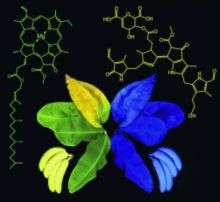Ripening bananas exhibit intense blue luminescence under UV light. Their luminescence arises from fluorescent chlorophyll catabolites which accumulate in the banana peels during ripening; their natural further conversion to nonfluorescent catabolites is specifically inhibited by a previously unrecognized chemical modification. (c) Wiley-VCH 2008
(PhysOrg.com) -- Ripe bananas are of course yellow. However, under black light, the yellow bananas are bright blue, as discovered by scientists at the University of Innsbruck (Austria) and Columbia University (New York, USA). The team, headed by Bernhard Kräutler, reports in the journal Angewandte Chemie that the blue glow is connected to the degradation of chlorophyll that occurs during ripening. In this process, colorless but fluorescing breakdown products of chlorophyll are concentrated in the banana peel.
The usual appearance of bananas is mainly the result of carotenoids. Under normal light, these natural pigments appear yellow. Under UV light, known to partygoers as black light, ripening bananas appear blue instead. There is no difference between naturally ripened bananas and those ripened with the use of ethylene gas. Green, unripe bananas do not fluoresce. The intensity of the luminescence correlates with the breakdown of the green pigment chlorophyll. As the ripening continues to progress, the blue glow decreases. “Surprisingly, this blue luminescence apparently has been entirely overlooked,” says Kräutler.
By means of various spectroscopic techniques, the team analyzed the structure of the main breakdown products. In doing this, they identified a propionate ester group, a modification never seen before in a chlorophyll breakdown product. This group has a stabilizing effect and could explain the unusually long duration of the fluorescing intermediates in bananas. Fluorescing chlorophyll catabolytes have otherwise only been found as short-lived intermediate products in higher plants.
Why does the breakdown of chlorophyll occur differently in bananas than in other higher plants, including even banana leaves? Kräutler suggests two different explanations: “In contrast to humans, many of the animals that eat bananas can see light in the UV range. The blue luminescence of the banana fruit could give them a distinct signal that the fruit is ripe.” Or perhaps the chlorophyll degradation products also serve a biological function for the banana. The amazingly stable catabolytes could help to prolong the viability of the ripening fruit.
Citation: Bernhard Kräutler, Blue Luminescence of Ripening Bananas, Angewandte Chemie International Edition 2008, 47, No. 46, doi: 10.1002/anie.200803189
Provided by Wiley
























